|
|
 |
 |
|
No.2 Unhealthy hooves
|
|
 |
 |
|
NOTE - Hoof nippers and a rasp alone
will never solve these horses problems
|
|
|
|
 |
 |
|
Hoof walls are a brilliant way of assessing equine health. All these hooves/horses are sick. The performance from all these horses was poor at the time pictures were taken. Changes in the horses lifestyle needed pronto !
a. Ripples running around the wall horizontally.
b. Ripples running around the wall then fanning downwards towards the back of hoof.
c. One ripple.
d. Twenty ripples.
e. Continuous cycle of ripples growing down the wall.
f. Big ripple, then an area of growth without ripples, then another ripple.
etc.... Pattern beginning to emerge here somewhere?!
The ripples are referred to by many names; stress rings, growth rings, grass rings, event lines, event rings and so on. The vast majority of Ripples are produced by systemic stress within the horse. (Occasionally ripples will be produced by mechanical forces eg. body issues / foot balance - an experienced hoof professional can help determine the cause).
Cracks running up the hoof wall from ground level in this type of hoof pathology will be just another symptom of systemic stress. Cracks in picture II can appear quickly when the horse is having problems. They can lead to bigger cracks and then infection has a place to attack the hoof and it will only get worse if the underlying triggers are not addressed. In picture IV this is exactly what has happened. underlying issues have not been addressed and infection is in the hoof wall. White line disease is now present.
g. Small or large vertical cracks present in any area of the hoof at ground level.
h. Chips, splits, fraying pieces of hoof wall, crumbly / powdery hoof wall.
i. Separation in hoof wall when viewed from the bottom.
j. Stones and dirt packed in the hoof wall when viewed from bottom.
|
|
|
When a hoof wall constantly changes angle or grows down in a bell shape it shows that the connection between hoof wall and pedal bone is having problems. The laminae is not coping and is unable to keep a well connected hoof wall from the top to ground level.
Picture VIII and picture IX both demonstrate that the hoof wall manages to connect to the pedal bone less than 1 cm before it is pulled away. Picture IX doesn’t have the ripples like VIII but both horses having trouble. Without changes these hooves will not perform well or improve.
Picture X is the same hoof in IX but viewed from the front to demonstrate the ‘belling’ of hoof wall.
k. when rasp held against front of hoof wall there will be daylight between wall and rasp.
l. Long toes.
m. Heels can become under run or get very high.
n. Flared wall at toe or sides of hoof.
o. Intermittent bruising on the wall which keeps appearing. Red rings running horizontally usually accompanied by ripples.
p. Hot spots anywhere on hoof wall.
|
|
|
|
 |
 |
|
The hooves opposite - XV / XVI / XVII / XVIII - are recognized by most people as being sick, but the problems are present a long time before hooves get to this level of pathology. Recognizing signs early on when the problems can be easily rectified will prevent hooves/horses deteriorating to such a level that only extreme dedication and commitment with every part of the horses lifestyle will return them to health.
Picture XVIII is the only hoof recently in shoes. The buckling and rippling of the hoof wall clearly shows the systemic stress the horse is facing. It has been the primary trigger in leading to further pathology and the wall becoming weak and brittle.
|
|
|
There are many reasons - aside from systemic stress - why hoof walls deviate in angle from the pedal bone. These range from saddle issues, body issues, limb abnormalities, injuries, arthritic joints. The list goes on.
Picture IXX - angle change on right of picture, half way down capsule shows healthy hoof (healing angle). Main factor here was proactive trimming / balancing the foot.
Picture XX - Well connected hoof wall half way down the hoof came from removing steel shoes four months previously.
|
|
 |
|
|
|
|
|
 |
 |
|
Frog health is determined by many factors: systemic stress, heels too high, heels contracted, infection, environment, irregular or poor foot trimming, neglect. The list goes on. Knowledge of what is a bad frog can be a powerful factor in returning the whole hoof back to health ! It is often overlooked, not taken seriously, not seen as a problem and consequently remains sick.
This is a big deal.
a. Narrow. Looks like a carrot, or worse still, a spring onion.
b. Pinched in at back.
c. Too much movement in heals.
d. Horse reacts to light pressure when palpated with fingers - imagine how a horse feels landing their full weight on a stone if they flinch at a light squeeze.
e. Foul odor, black / gray mush - usually in central sulcus but can be anywhere on frog.
f. Fissures in frog, small cracks running up frog at the back, large cracks running up between heal bulbs.
g. Head of hoof pick disappearing when picked out, or horse pulls foot away when picked out in and around frog.
h. Flaps of frog tissue, areas not filled in.
i. Horse lands toe first to avoid pain in back of foot.
|
|
 |
|
|
|
|
|
 |
 |
 |
|
Soles are a great tool in assessing what a horse will perform like on their feet. These soles did not perform well on uneven and rocky terrain at the time pictures taken.
a. Thin soles.
b. Sole flexing by using thumb pressure around point of frog. Horse will flinch and pull foot away.
c. Looks flat, no depth in the groove around the frog
d. Horse footy on hard, uneven, rocky terrain.
e. Landing excessively heal first to protect thin sole in front part of foot.
f. Small stones held around groove next to frog can make horse foot sore.
g. Bruising, black necrotic tissue, holes, fissures.
h. Mud packed in foot makes horse foot sore.
i. Soles that are convex (...PANIC STATIONS) - III / IV
Systemic stress is the main cause of bad soles on horses. Addressing hoof care with an holistic approach will prevent soles getting to such a level that a horse can flinch by gentle thumb pressure alone.
|
|
|
|
Picture V Infection was present in the toe area and tracked up deep into hoof wall. A topical treatment was necessary to prevent further damage.
Picture VI is a sole doing what nature does best. This horse put out a sole callous all the way around the sides and front of frog to support the foot. It helped stabilize the foot when it was having difficulty. When the trigger / underlying cause was addressed the callous wore off by itself.
Picture VII pieces of sole - that were part of a sole callous around the frog to support the inflamed hoof - are now falling off by themselves, the pieces can be peeled off easily with fingers. This had been a sick hoof BUT the underlying cause was addressed and the hoof / horse returned to health.
Picture VIII sole callous helping out the hoof out. The triggers led this horse to abscess / infection / inflammation / toxic overload etc. all resolved when the underlying cause was addressed.
|
|
|
A sole that appears flat is not always thin or inadequate. Soles can look like they have no ‘concavity’ but they provide ample sole depth for the horse. Weather patterns, time of year, workload, surfaces the horse lives and works on, where the horse spends their time, climate, the list goes on... can effect the sole and it’s appearance.
Just because a sole looks flat does not mean that the horse will not perform well. It is misleading to put all flat looking soles into one box.
Pictures - IX / X - this soles looks flat, no concavity etc. However picture XI shows that there is some depth but it just needed further clarification. Picture XII - sole material came away just by lightly scraping away the surface with a hoof pick. There are fine cracks fanning out from the frog which show the ‘live’ sole is still not exposed. It was a period of wet weather following a dry spell which started the process of exfoliation.
Not all ‘flat’ soles are bad ! it just takes time to learn. The horses performance will tell you if the sole is right for them.
|
|
 |
|
|
|
 |
 |
|
 |
 |
 |
 |
 |
|
Bad internal structure in the back of hoof
|
|
|
|
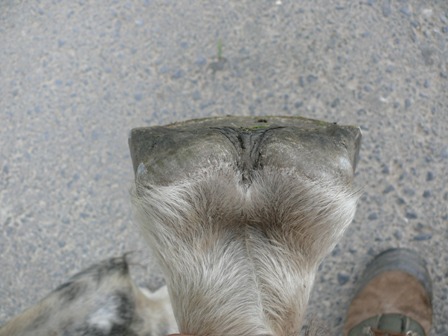 |
|
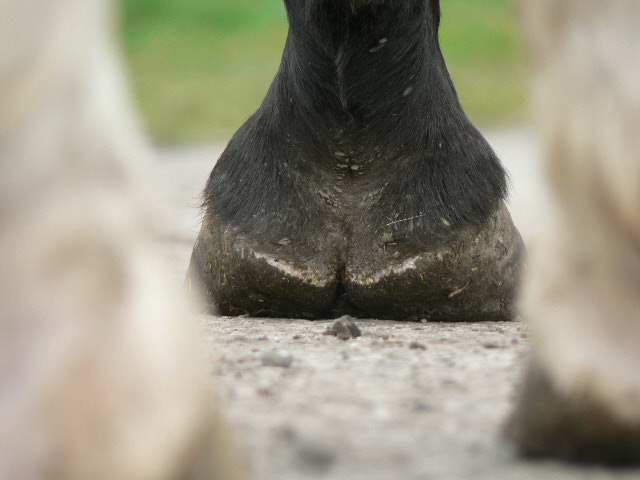 |
|
|
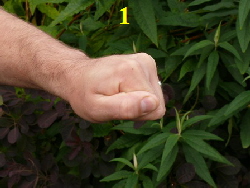 |
|
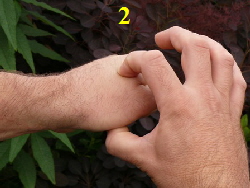 |
|
|
|
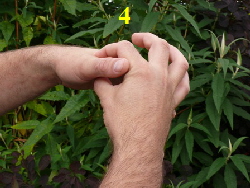 |
|
|
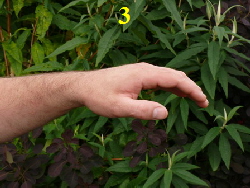 |
|
|
|
|
|
|
 |
|
|
|
|
|
 |
 |
|
Poor white lines are the result of many factors. The main cause is a horse under systemic stress. Other causes may be neglect or poor / irregular hoof trimming. The white lines opposite all demonstrate the former.
a. White line is 3 mm wide or greater. The wider the gap the more sick the hoof is.
b. Infection often present; black necrotic tissue in the area between sole and wall.
c. Stones, dirt and debris get packed into the area
d. Can have a feathered appearance - picture I
Once the integrity of the white line is compromised it opens up the area to penetration from foreign matter. Infection or stones invading the void can start to seriously effect the foot and soundness of the horse. It is important to find out why the white line is stretched and deal with the underlying issues.
Picture III - stones and debris have pushed up high into the hoof wall. This is now a long, deep ravine that is effecting the integrity of the wall itself.
|
|
 |
|
|
[Unhealthy hooves] [Home] |
 |
 |
|
© Progressive Horse 2011. All rights reserved
|
|